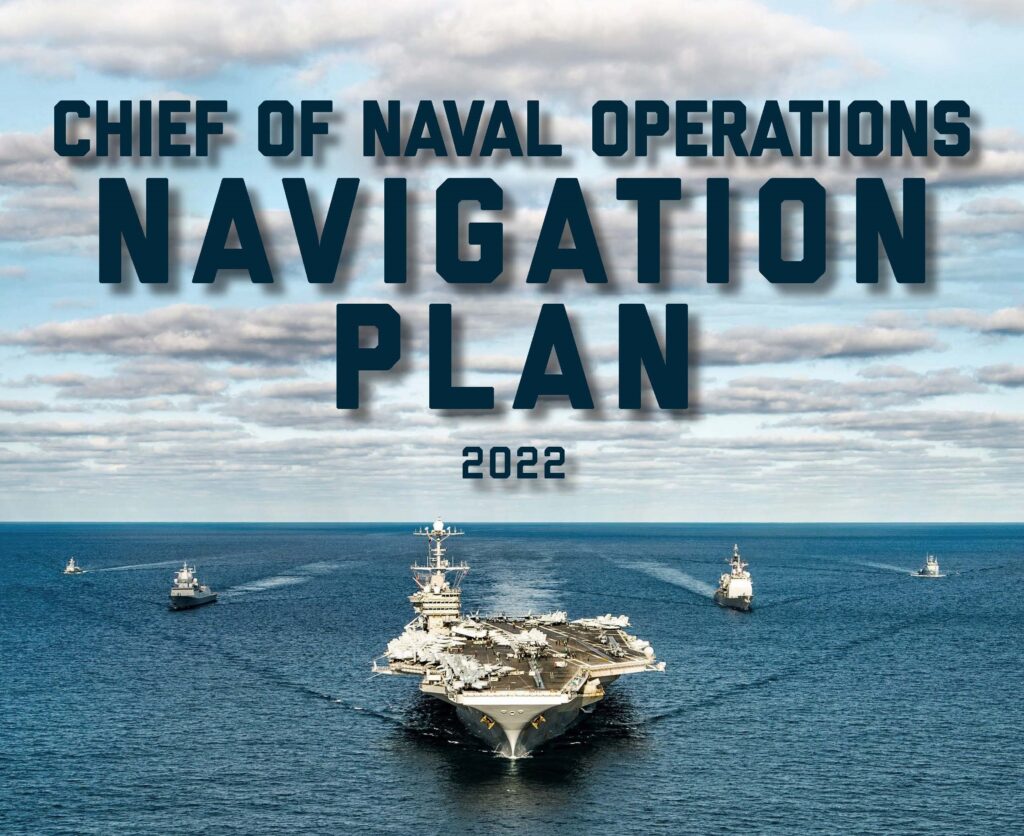
ARLINGTON, Va. — The update to the chief of naval operation’s Navigation Plan incorporates the Navy’s Force Design 2045 ship and aircraft force level goals for 2045, a hybrid fleet in which manned ships will remain dominant but supplemented by significant numbers of unmanned systems.
The NAVPLAN, released July 26, has been informed by recent fleet exercises, including IMX-22 held by Task Force 59 earlier this year and the Rim of the Pacific exercises, CNO Adm. Michael Gilday, now in his third year in office, said during a July 26 roundtable with reporters.
The plan complies with the National Defense Strategy and the CNO’s priorities on Sailors, readiness, capability and capacity.
“The Navy must be capable of controlling the seas to deter aggression against our allies and partners, and project power ashore as an integral part of the Joint Force,” the CNO says in the NAVPLAN. “The Navy will incorporate our force design imperatives — distance, deception, defense, distribution, delivery, and decision advantage — to effectively integrate with the joint force, deliver effects across all domains and defeat adversary forces in conflict.
“To accomplish this, the Navy must become a hybrid fleet. Manned, multi-mission platforms will remain at the core of our future fleet but augmented with new platforms and new capabilities. We will add to our current fleet a host of manned, unmanned and optionally manned platforms operating under, on, and above the seas. This future fleet will deliver an assured strategic deterrent; greater numbers of undersea capabilities; a mix of large and small modern surface combatants; and a resilient logistics enterprise that can sustain our distributed naval force.”
Gilday said the future fleet would require a 3% to 5% annual increase in the Navy’s budget, noting that the shipbuilding request of $27 billion is the highest ever but also affirming that a long time will be required to build up the size of the fleet to meet the goals in 2045.
“I think it’s going to take a couple of decades to yield that hybrid fleet that we think that we ultimately need in order to fight the way we think we want to fight in a distributed manner, leveraging networking like JADC2 and the effort that we have ongoing with Overmatch,” Gilday said. “All that is going to take time. I’m being realistic. We don’t have the capacity in the industrial base to pump out that number of ships in a short period of time.”
Force Design 2045 envisions a hybrid fleet of “more than 350 manned ships, 150 large, unmanned surface and subsurface platforms, and approximately 3,000 aircraft,” the plan says, noting the numbers will be refined as the security environment changes.
The capacity goals of Force Design 2045 include:
- 12 Columbia-class nuclear-powered ballistic-missile submarines
- 12 nuclear-powered aircraft carriers
- 66 nuclear-powered fast-attack and large-payload submarines, continuing with the Virginia class and developing the SSN(X)
- 96 large surface combatants, including the Flight III Arleigh Burke-class DDG and the DDG(X)
- 56 small surface combatants, including the Constellation-class FFG
- 31 large amphibious warships
- 18 light amphibious warships
- Approximately 150 unmanned surface and subsurface vessels
- 82 combat logistic and auxiliary ships
- Increased expeditionary logistics capacity
- Approximately 1,300 carrier-based fifth-generation strike fighters and Next-Generation Air Dominance Family of Systems
- Approximately 900 maritime patrol, reconnaissance, anti-submarine and anti-surface fixed-wing and rotary-wing aircraft, augmented by unmanned aircraft
- Approximately 750 intra-theater lift, training, and research and development aircraft.
“We will augment the force with an evolving complement of thousands of small, rapidly adaptable, and attritable unmanned platforms,” the NAVPLAN says. “These enablers will increase our sensing resilience, persistence, and coverage, provide cross-domain kinetic and non-kinetic effects, and enhance the survivability and sustainability of the future fleet. We will build future platforms with modernization in mind — hardware upgradeable and software updateable at the speed of innovation. We must build adequate space, weight, and power into our large long-life capital investments to support evolving sensors and weapons systems.”
The NAVPLAN is available here.
- SECNAV Advocates Increased Legal Immigration to Increase Shipbuilder Workforce - April 23, 2024
- Insitu Going Strong at 30, Focusing on Maritime Operations - April 8, 2024
- Navy Awards Boeing Additional Funds for MQ-25 Drones for Testing - April 3, 2024






